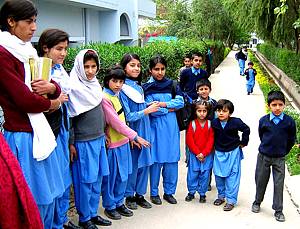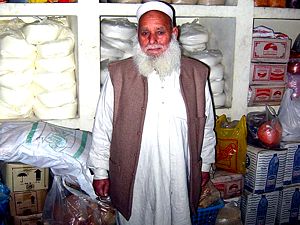Recently, at short notice a colleague and I learned we were making a brief trip to Islamabad, the capital of Pakistan. We quickly learned that the international airport is actually closer to the ancient city of Rawalpindi, located on a northern plateau inhabited for nearly 3000 years but dating in its more modern form since 1493. Today, the city hosts some 1.4 million people. We also learned that “Pindi” actually served as the nation's capital while the new city of Islamabad was being built nearby. Some asked whether we would be safe there and then our travel plans were abruptly changed with the announcement that President Bush’s Pakistan visit had booked out all hotel facilities. A security perimeter of 1-3 km in circumference made it impossible to move around the city so we were happy to wait until “Dubya” left town.

Colourful Suzuki Minibuses are major providers of public transportation
We were exploring the plight of children and young people who had
survived the October 2005 earthquake that devastated northern Pakistan.
Many of these survivors have spent the harsh mountain winter living in
tent communities as NGOs and governmental agencies have struggled to
rebuild peoples” homes and help them reconstruct their lives. One of our
visits was to the SOS Children's Village at Rawalpindi where a number of
survivors were living in a community of some 200-300 people. At the time
of the earthquake, this Children's Village – like others in the region – made special emergency provision for these children and families.

Children & Young people from the Kashmir area staying at Rawalpindi
The SOS Children's Village at Pindi follows the care philosophy
established by Hermann Gmeiner at the first village created by this
international child welfare movement in a small Austrian town in 1949
for war orphans and homeless children. The SOS–Kinderdorf International
website at (http://www.sos-childrensvillages.org)
explains how SOS Children's Villages help children who have lost their
parents or who are no longer able to live with them a permanent home and
a stable environment. SOS Children's Villages are formed by four basic
principles: mother, brothers and sisters, house and village. Each child
is given a designated SOS mother who cares for this child and serves as
a substitute for the child's natural parents. She lives in a house
together with the children that she is looking after and organises the
family’s daily life, creating strong and dependable relationships and
giving the children a safe and loving home. The job of an SOS Children's
Village Mother is usually carried out by single women who have completed
an extensive training programme.
Educational facilities are readily available to children at the Pindi Children's Village. Kindergarten, Primary and Secondary School opportunities are provided for village children and also for children living with their own families nearby. Vocational training is offered for the older children, with a youth hostel for older boys who have left the immediate family groups and start preparing for independent living. A health clinic is available on-site for village residents as well as for local community members. A dentist visits weekly to attend to children's oral hygiene. We were very deeply moved by the standards of care provided by the Rawalpindi Children's Village and very much appreciated the caring way we were hosted by staff and children alike!
The much-loved keeper of Rawalpindi’s SOS Children's Village food store
